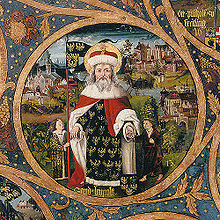Leopold III, Margrave of Austria
Saint Leopold III | |
|---|---|
 Saint Leopold III with two deceased sons, Babenberger Stammbaum, Klosterneuburg Monastery, 1489–1492 | |
| Margrave of Austria | |
| Born | 1073 Melk, Austria |
| Died | 15 November 1136 Klosterneuburg abbey, Lower Austria, Austria |
| Venerated in | Roman Catholic Church |
| Canonized | 6 January 1485 by Pope Innocent VIII |
| Feast | 15 November |
| Attributes | Model of church |
| Patronage | Austria Lower Austria Upper Austria Vienna Death of children Large families Step-parents |
Leopold III | |
|---|---|
| Margrave of Austria | |
| Margrave | 1095–1136 |
| Predecessor | Leopold II |
| Successor | Leopold IV |
| Family | House of Babenberg |
| Spouse | Agnes of Germany |
| Issue | Leopold IV Henry II Jasomirgott Agnes Otto of Freising Judith Gertrude |
| Father | Leopold II |
| Mother | Ida of Formbach-Ratelnberg |
Saint Leopold III (German: Luitpold, 1073 – 15 November 1136), known as Leopold the Good, was the Margrave of Austria from 1095 to his death in 1136. He was a member of the House of Babenberg. He was canonized on 6 January 1485 and became the patron saint of Austria, Lower Austria, Upper Austria, and Vienna. His feast day is 15 November.[1]
Life
Leopold was born at Babenberg castle in Gars am Kamp, the son of Margrave Leopold II and Ida of Formbach-Ratelnberg. The Babenbergs came to Austria from Bavaria where the family had risen to prominence in the 10th Century.[2]
In 1096 Leopold succeeded his father as margrave of Austria at the age of 23. He married twice. His first wife may have been one of the von Perg family, who died in 1105. The following year he married Agnes, the widowed sister of Emperor Henry V whom he had supported against her father Henry IV. This connection to the Salians raised the importance of the House of Babenberg, to which important royal rights over the margravate of Austria were granted. Also, Agnes had influential connections through her previous marriage to Frederick of Hohenstaufen,[2] one of her sons being Conrad III of Germany.
Leopold called himself "Princeps Terræ", a reflection of his sense of territorial independence. He was considered a candidate in the election of the Kaiser of the Holy Roman Empire in 1125, but declined this honour.
He is mainly remembered for the development of the country and, in particular, the founding of several monasteries. His most important foundation is Klosterneuburg (1108).[2] According to legend, the Virgin Mary appeared to him and led him to a place where he found the veil of his wife Agnes, who had lost it years earlier. He established the Klosterneuburg Monastery there. He subsequently expanded the settlement to become his residence.
Leopold also founded the monasteries of Heiligenkreuz, Kleinmariazell and Seitenstetten which developed a territory still largely covered by forest. All of these induced the church to canonize him in 1485.
Leopold also fostered the development of cities, such as Klosterneuburg, Vienna and Krems. The last one was granted the right to mint but never attained great importance.
The writings of Henry of Melk and Ava of Göttweig, which are the first literary texts from Austria, date back to Leopold's time.
He is buried in the Klosterneuburg Monastery, which he founded. His skull is kept in an embroidered reliquary, which leaves the forehead exposed; it also wears an archducal crown.
In 1663, under the rule of his namesake Emperor Leopold I, he was declared patron saint of Austria instead of Saint Koloman.
The brothers Joseph and Michael Haydn, each of whom sang in the choir of St. Stephen's Cathedral, both sang in that capacity at Klosterneuburg on this day. Joseph Haydn later became the more famous composer of the two. Michael Haydn later (1805) wrote a Mass in honour of Leopold, the Missa sub titulo Sancti Leopoldi.
Children
By his first marriage, possibly to a lady of the Perg family:
- Adalbert or Albert II The Devout, Markgraf (1136–1137), d. 1137
By his second wife, Agnes of Germany, widow of Frederick I, Duke of Swabia:
- Leopold IV
- Henry II Jasomirgott.
- Berta, m. Henry III, Burggraf of Regensburg.
- Agnes, m. Władysław II of Poland.
- Ernst.
- Otto of Freising, Bishop and biographer of his nephew (from his mother's first marriage), Emperor Frederick I "Barbarossa".
- Conrad, Bishop of Passau and Archbishop of Salzburg.
- Elizabeth, m. Hermann II of Winzenburg.
- Judith, m. William V of Montferrat.
- Gertrude, m. King Vladislaus II of Bohemia.
According to the Continuation of the Chronicles of Klosterneuburg, there may have been up to seven others (possibly from multiple births) stillborn or died in infancy.
Gallery
-
Stained glass, Gaaden, Lower Austria
-
Österreichische Schule, eighteenth century
-
Saint Leopold Chapel, Stephansdom
See also
References
- Citations
- ^ Lingelbach 1913, pp. 90–91.
- ^ a b c "St. Leopold of Babenberg", Canons Regular of St. Augustine
- Bibliography
- Beller, Steven (2007). A Concise History of Austria. New York: Cambridge University Press. ISBN 978-0521478861.
- Brooke, Z. N. (1938). A History of Europe: From 911 to 1198. London: Methuen & Company Ltd. ISBN 978-1443740708.
- Dopsch, Heinz (1999). Österreichische Geschichte 1122-1278. Vienna: Ueberreuter. ISBN 3-8000-3973-7.
- Lechner, Karl (1976). Die Babenberger: Markgrafen und Herzoge von Österreich 976–1246. Vienna: Böhlau. ISBN 978-3205085089.
- Leeper, Alexander W. (1941). History of Medieval Austria. London: Oxford University Press. ISBN 978-0404153472.
- Lingelbach, William E. (1913). The History of Nations: Austria-Hungary. New York: P. F. Collier & Son Company. ASIN B000L3E368.
- Pohl, Walter (1995). Die Welt der Babenberger. Graz: Verlag Styria. ISBN 978-3222123344.
- Rickett, Richard (1985). A Brief Survey of Austrian History. Vienna: Prachner. ISBN 978-3853670019.
- Wegener, Wilhelm (1965). Genealogischen Tafeln zur mitteleuropäischen Geschichte. Vienna: Verlag Degener.



